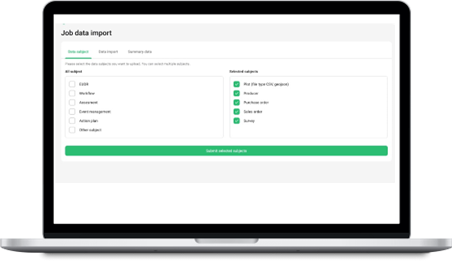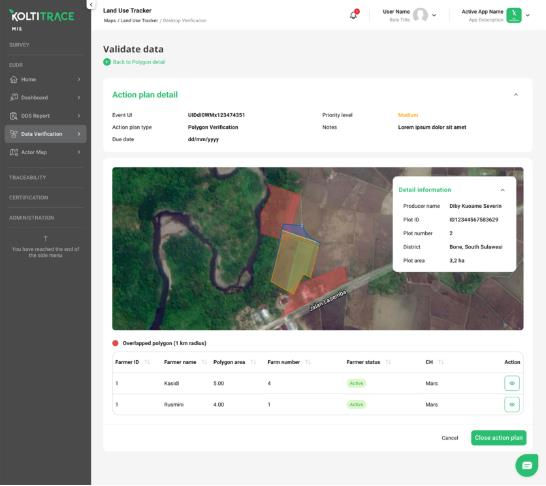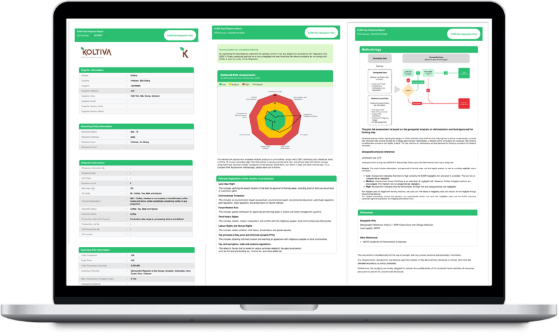How to Resolve Non-Negligible Deforestation Risk: Verified Due Diligence for EUDR Mitigation
- Maria Marshella Gaviota

- Aug 14
- 9 min read
Editor's Note:
With EUDR enforcement deadline draws near, data collection alone no longer guarantees compliance, companies must prove, in a format the EU Information System accepts, that every non-negligible risk has been resolved. True readiness depends on weaving risk alerts into auditable resolution workflows. In this article, Koltiva’s Product Manager, Brian Koh, shares how field operations and desktop analytics are integrated to create a unified verification trail. Michael Saputra, our Head of Data Collection & Climate, explains how the system is built for machine-readable, submission-ready compliance, supporting companies to meet EUDR requirements with traceability, speed, and confidence.
Executive Summary:
The EUDR shift the compliance challenge from data collection, identifying deforestation risk to proving its resolution. Companies must provide verifiable, traceable, and defensible evidence that every “non-negligible” risk has been mitigated before products enter the EU market.
Only 3% of companies take adequate action to address deforestation (Forest 500, Global Canopy 2025), exposing a critical industry gap. The majority still fail to operationalize deforestation risk mitigation and deliver the robust, auditable evidence required for legally compliant EUDR Due Diligence Statements.
A new approach is needed to transform manual compliance into a coherent, defensible workflow. The regulation's legal text, Regulation (EU) 2023/1115, mandates that companies cannot delay or delegate the resolution of "non-negligible risk." This requires a standardized, auditable framework for risk resolution. A traceability-integrated CMS turns risk alerts into structured workflows, ensuring that mitigation actions, deadlines, and verification requirements are tracked and documented across all supply chain actors for EUDR-ready Due Diligence Statements (DDS).
CMS Capabilities Drive Market Access – Compliance Management System (CMS)-embedded verification processes, from polygon and supplier validation to ground-truth inspections, create an auditable chain of evidence that satisfies EUDR scrutiny, accelerates case closure, and safeguards EU market access.
Introduction: EUDR Compliance Demands More Than Detection
The EU Deforestation Regulation (EUDR) changes the rules of the game. Mapping supply chains and identifying deforestation risks, once seen as the most challenging part, is now just the beginning. With the rise of geolocation technologies, satellite imagery, and polygon mapping tools, producers and traders can now map supply chains and identify deforestation risks down to individual plots. These tools have made technical traceability more achievable than ever.
However, as the December 30, 2025 enforcement deadline for the EUDR approaches, capability alone is no longer sufficient. EUDR compliance demands that companies move beyond detection to deliver documented, defensible proof that every “non-negligible” risk has been assessed, mitigated, and verified. The compliance burden now extends beyond detecting risk, it requires actionable traceability and robust verification workflows across complex, multi-actor supply chains.
This is especially evident in the final stage of compliance: submitting a Due Diligence Statement (DDS) through the EU Information System (EUIS). Identifying at-risk plots is only the first step. Companies must also provide traceable, defensible evidence of how each “non-negligible” risk has been assessed and resolved.
The greatest hurdle is not just detection but operational execution: turning risk alerts into a clear, auditable chain of evidence. Here, companies must not only identify at-risk plots but also demonstrate, with verifiable evidence, how each risk has been resolved.
A Compliance Management System (CMS) fills this gap. By integrating technology, structured workflows, governance, and centralized accountability to turn detection into proof, and proof into compliance, a CMS features on the EUDR Solutions helps businesses achieve regulatory compliance while enhancing operational efficiency. Turns detection into proof, and proof into compliance.

Table of Contents:
Why EUDR Compliance Needs a Structured Compliance Management System (CMS)?
The Forest 500 Report (Global Canopy, 2025) reveals a stark truth: Only 3 percent of companies with influence over forest-risk commodities are demonstrating adequate action on deforestation, and just 8% report more than half of their commodity volumes as deforestation- and conversion-free across all commodities assessed.
A further 22% demonstrate credible implementation for one or more commodities, showing evidence of monitoring impacts, engaging suppliers, and reporting progress. The remaining majority lag far behind, a sign of systemic operational shortcomings. Without centralized accountability, documented evidence, and timely follow-up, many businesses stall between the initial alert and the proof required for verification.
Once a plot is flagged with “non-negligible risk,” companies must take appropriate measures to reduce the risk to at least negligible. Each case must be actively managed and supported with verifiable mitigation evidence (Regulation (EU) 2023/1115, 2023). Yet in practice, many businesses struggle to operationalize this step.

Without standardized workflows or integrated case management, the path from alert to verified resolution remains fragmented and inefficient. The result is stalled timelines and proof gaps:
Missed compliance windows: Risk resolution becomes reactive and inconsistent, leading to delays. Risk cases remain open beyond EUDR timelines because resolution steps are untracked and unmanaged.
Manual inconsistency and disjointed follow-up: Supplier engagement and remediation actions are scattered across tools and channels from email chains, spreadsheets, and offline files, which are difficult to audit.
Unverifiable outcomes, proof gaps: Mitigation case evidence is hard to compile, audit, or defend, leaving businesses vulnerable during inspections.
A traceability-integrated CMS centralizes compliance data, connects supplier verification to geolocation, and streamlines DDS submissions. Without it, companies risk delays, failed audits, and costly barriers to EU market access.
The Role of Digital Solutions in Deforestation-Free Supply Chains
Traditional compliance methods—manual documentation, fragmented spreadsheets, and isolated databases—are insufficient for today’s regulatory demands. Digital traceability solutions empower companies to achieve a transparent supply chains:
Mapping supply chains with polygon-based geolocation data.
Automating risk detection and alerts.
Enabling real-time supplier engagement.
Providing auditable records for regulatory inspections.
By integrating sustainability compliance into day-to-day operations, digital solutions not only ensure legal adherence but also strengthen long-term supply chain resilience.
How Traceability-CMS Integrated Support Credible Risk Resolution
The market demands more than just risk alerts, it needs a solution that transforms these raw alerts into a structured, verifiable process. A Compliance Management System (CMS) provides exactly that: a defined framework of tools, processes, and governance protocols to ensure businesses meet legal and regulatory obligations.
In the context of the EUDR, a CMS enables seamless data collection, rigorous verification, and transparent reporting to demonstrate deforestation-free sourcing. EUDR compliance relies on a company’s ability to integrate traceability, risk assessment, and reporting into a unified operational flow. By embedding these elements into business processes, a CMS transforms compliance from a costly obligation into a strategic advantage.
KOLTIVA’s CMS is a fully integrated, robust platform purpose-built to meet the unique demands of EUDR compliance. It unites all supply chain actors: farmers, cooperatives, traders, processors, and exporters into a single, auditable data ecosystem.
Embedded within KoltiTrace MIS, the Koltiva’s CMS is engineered precisely for this purpose. Built to support both upstream and downstream actors, the CMS structures your EUDR resolution journey across four connected stages, ensuring every alert leads to a verifiable outcome.
Stage 1: Data Submission, Building the EUDR Evidence Base

Under EUDR, every shipment must be backed by complete geolocation data and supplier declarations. Koltiva’s CMS captures these inputs seamlessly via pre-shipment forms, bulk data uploads, or mobile field data collection. Each entry records polygon boundaries, plot-level metadata, and supplier compliance statements in standardized formats, ensuring your due diligence process starts with credible, audit-ready information.
Stage 2: Data Verification, Screening for EUDR Risk Factors

EUDR requires businesses to assess the risk of deforestation and illegal sourcing before placing products on the EU market. In this stage, the system conducts a series of consistency and logic checks to validate entries against expected parameters. Each polygon undergoes spatial quality control, ensuring plot boundaries match field realities. A built-in risk engine then classifies each polygon based on deforestation exposure, setting the stage for case creation where needed.
Stage 3: Case Resolution (Non-Negligible Risk Only)
If the risk assessment flags a supplier or plot as “non-negligible” under EUDR, the CMS automatically opens a case file and guides users through a structured mitigation plan. Actions follow EUDR’s due diligence principles, four targeted verification pathways:
Ground Truthing involves field visits to verify plot data against real-world conditions, supported by GPS-tagged photos and field agent observations.
Polygon Verification scrutinizes the spatial boundaries of each plot, comparing satellite imagery with field-drawn polygons to confirm accuracy.
Supplier Verification reviews the documentation and records associated with individual suppliers, including ownership proof, production history, and compliance records.
Desktop Verification is conducted via remote methods, analyzing satellite imagery, historical deforestation data, and documentation to support or dismiss alerts without a field visit.

All findings are logged in a centralized, geo-referenced audit trail. The system triggers automated follow-ups and escalations to prevent case stagnation.
Stage 4: Reporting, Generating EUDR-Ready Due Diligence Statements
After cases are resolved, the CMS compiles a complete verification record into an EUDR-compliant Due Diligence Statement (DDS). These reports can be shared with downstream buyers or exported into DDS-ready formats for EUIS submission. Every case includes a complete verification trail, reinforcing trust in the resolution process.

CMS Core Capabilities for Resolving EUDR-Aligned Deforestation Mitigation Risks
Under the EU Deforestation Regulation (EUDR), simply detecting risks is not enough. Companies must demonstrate that every “non-negligible” deforestation risk has been assessed, mitigated, and verified before products enter the EU market. An effective Compliance Management System (CMS) must therefore go beyond alerting; it must enable users to resolve risks systematically, document every action, and maintain an auditable trail for compliance authorities.
Koltiva’s CMS is engineered to do exactly that. Built for complex, multi-origin supply chains, it transforms compliance alerts into coordinated workflows that combine clarity, accountability, and automation, enabling teams to close cases efficiently, reduce oversight, and maintain continuous EUDR readiness.
Core capabilities of CMS feature on EUDR Solutions Koltiva include:
Structured Action Plans – Define precise, plot-level mitigation measures with assigned responsibilities, deadlines, and verification requirements, ensuring no step in the EUDR risk resolution process is missed.
Real-Time Compliance Tracking – Monitor the status of every case across all actors, commodities, and regions from a single dashboard, providing the visibility needed for EUDR’s ongoing due diligence obligations.
System-Driven Notifications – Automated reminders and escalation alerts keep all stakeholders on track, ensuring non-negligible risks are resolved within the required timelines before a Due Diligence Statement (DDS) is submitted.
By integrating these capabilities, Koltiva’s CMS turns passive alerts into evidence-backed actions, ensuring risk resolution is not only swift but also fully documented for regulators and downstream buyers.
These capabilities transform passive alerts into coordinated workflows, empowering teams to act swiftly and confidently.
“The strength of CMS lies in how it operationalizes data. Instead of leaving risk alerts as static flags, we embed them into a living system of follow-up actions, timelines, and accountability. This is how our clients turn traceability into regulatory resilience.” — Brian Koh, Product Manager at Koltiva

Why a Compliance Management System is Essential
A well-structured Compliance Management System (CMS) forms the operational bridge between risk detection and a legally defensible Due Diligence Statement (DDS). Without them, even accurate detection data can fail to meet regulatory scrutiny.
EUDR compliance hinges not just on data collection but on a documented process to resolve risk. By converting alerts into verified, auditable actions, KoltiTrace’s CMS reinforces the integrity of your due diligence journey.
Whether you are a first-mile supplier or a downstream trader, structured verification supports your business with:
Reduced compliance friction: Automatically link supplier plot status to geolocation data and risk classifications, ensuring EUDR-mandated risk resolution steps are tracked without excessive manual oversight.
Faster, regulation-aligned case closure: Use CMS-driven task assignments, escalation alerts, and verification pathways to resolve “non-negligible” risks within the strict timelines required under EUDR.
Stronger EUDR audit readiness: Maintain a complete, geo-referenced record of mitigation actions, verification evidence, and DDS-ready outputs to meet EUIS submission standards with confidence.
In the EUDR context, verification is not a bureaucratic burden, it is the foundation of market access. Companies that embed the CMS into their compliance processes transform regulatory requirements into a source of operational confidence, supply chain credibility, and business continuity.
“We designed the CMS to record every action in a structured, machine readable way, enabling seamless export to the EUIS. That means clients can submit due diligence statements without scrambling to reformat disparate records. Compliance becomes traceable, exportable, and defensible—precisely what EUDR requires.” — Michael Saputra, Head of Data Collection & Climate at Koltiva
As risk detection tools generate more flags, only structured verification can close the compliance loop. Our solution ensures that every alert leads to a resolved, documented case, enhancing your ability to meet EUDR standards with confidence.
Ready to transform your compliance process into a verified advantage?
Author: Maria Marshella Gaviota, Marketing Communications Officer at KOLTIVA
Subject Matter Expert: Brian Koh, Product Manager at KOLTIVA and Michael Saputra, Head of Data Collection & Climate at KOLTIVA
About:
Brian Koh is a seasoned Product Manager at KOLTIVA with over five years of experience in project management, business analysis, and problem solving. He is deeply engaged in agile working processes and developing quick-turnaround, impact-driven solutions. At KOLTIVA, he focuses on designing and improving workflows that connect field operations with data-driven insights, supporting businesses in meeting compliance requirements under regulations such as the EU Deforestation Regulation (EUDR) while maintaining transparent and traceable supply chains.
Michael Saputra is the Head of Data Collection and Climate at KOLTIVA, leading initiatives that integrate climate intelligence with robust field data systems across global agricultural supply chains. With expertise in geospatial analysis, environmental monitoring, and digital traceability, Michael ensures that data collected from the ground up—down to the farm plot—supports compliance with sustainability frameworks like the EU Deforestation Regulation (EUDR). His work bridges technology and climate action to empower businesses and smallholders in building resilient, transparent, and deforestation-free supply chains.
Resources:
Global Canopy. (2025). Forest 500: The companies and financial institutions with the greatest influence on deforestation, and what they are doing about it (2025 ed.). https://forest500.org/wp-content/uploads/2025/07/F500_Editorial_2025.pdf
Regulation (EU) 2023/1115 of the European Parliament and of the Council of 31 May 2023 on the making available on the Union market of certain commodities and products associated with deforestation and forest degradation. (2023). Official Journal of the European Union. https://eur-lex.europa.eu/legal-content/EN/TXT/PDF/?uri=CELEX:32023R1115










I’m eager to see how such integrated solutions can be scaled across critical commodities, turning compliance from a checkbox into long-term resilience!